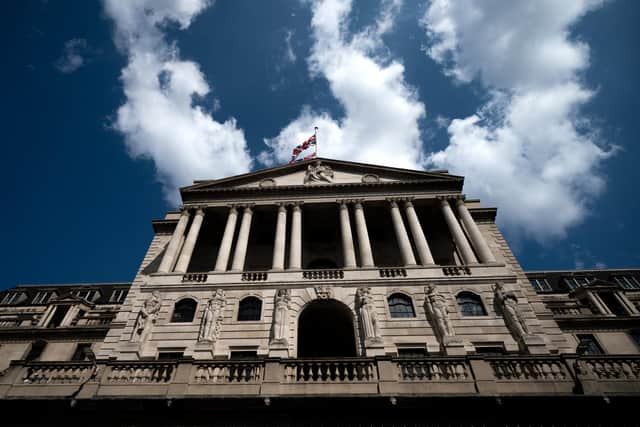UK inflation analysis: Interest rate cut still on cards in 'pivot' year despite troubling figures
Hopes for an early cut in interest rates appeared to have been dashed following an unexpected uptick in inflation but with the UK economy teetering on the edge of recession the Bank of England may find its hand forced.
Inflation has more than halved since peaking at an annual rate of 11.1 per cent in October 2022, following a series of interest rate hikes, but news of an increase to 4 per cent in December, from November’s low of 3.9 per cent, came as a surprise to most economists and observers. It nudged higher after alcohol and tobacco inflation hit a high of 12.8 per cent last month, largely following the increased tobacco duty in November. This offset a further easing in food inflation, which fell back to 8 per cent last month - down from 9.2 per cent in November and the lowest rate since April 2022. Average car insurance costs, which are also factored into the data, have also risen sharply in recent months.
Advertisement
Hide AdAdvertisement
Hide AdMost economists had expected the annual headline rate of inflation to ease further to 3.8 per cent last month, but with rising geopolitical tensions stoking fears of higher oil prices and subsequently higher prices for many goods in the shops, inflation’s downward trajectory cannot be taken for granted.


Michael Hewson, chief market analyst at CMC Markets UK, said that while goods inflation, including the likes of food, drink and general household products, appeared to be largely under control, services inflation - covering areas such as hospitality and transport - still looked “sticky”. He said: “[These] inflation numbers serve to reinforce the challenge facing the Bank of England in returning inflation to target and show that the process is unlikely to be linear, with markets pushing back the timing of the first cut to the middle of the summer.
“[The first quarter of 2024] was never a realistic probability even if you believe, as some do, that we could see UK inflation fall to the Bank of England’s target of 2 per cent by the beginning of Q2. Even if that were to happen, we would have no certainty of that until May when the April data is released which means the possibility of a May cut is ambitious. The only debate now is not whether we see rate cuts this year, it is when we see rate cuts.”
There was some relief for households in the latest figures as food price rises eased back once more, coming back down further from the 45-year highs seen in 2023. The Office for National Statistics (ONS) said prices also fell at the fuel pumps, with the average price of petrol down by 8.2p a litre between November and December to stand at 142.8p. Diesel prices fell by 7.6p a litre this year to stand at 151.4p. The figures showed that airfares rose as usual between November and December, up by 57.1 per cent, compared with a 61.1 per cent rise a year ago.
The inflation numbers come after official data released on Tuesday showing that wage growth had slowed to its lowest rate for ten months increased expectations that the UK central bank could consider cutting interest rates from their 15-year high of 5.25 per cent.


Rob Morgan, chief investment analyst at Charles Stanley, predicted that inflation would likely resume its downward path over the coming months but warned that the outlook remained uncertain.
He said: “Central banks are attempting to stuff the inflation genie back into the bottle through higher interest rates. Following a period of restrictive rates, 2024 is the year of the ‘pivot’ when they can turn their attention to when to cut rather than worrying whether they might raise them further.
“This is easier said than done as monetary policy acts with a long and variable lag, which presents a double-edged risk for the BoE: Slash rates too soon and inflation might creep back; cut too late and there may be more economic damage than necessary. Like landing a plane in a storm the BoE will aspire to get the trajectory just right.
Advertisement
Hide AdAdvertisement
Hide Ad“The UK teeters on the edge of recession and the heat is coming out of wage rises. However, as [the latest] data illustrates, inflation’s downward trajectory cannot be taken for granted and consequently the market may have jumped the gun around the timing of rate cuts.”
There are concerns over the impact of the Red Sea shipping attacks on inflation, as it threatens to push up the cost of oil, gas and goods being imported to the UK, and other countries.
George Lagarias, chief economist at Mazars, noted: “It should be no surprise that British inflation rose in December. Similar data from the US and the EU as well as other forward-looking reports have suggested that prices were ripe for a rebound.
“Price rises are a symptom of persistent geopolitical instability and competition, a theme that will likely stay with us for most of the year. Having said that, we don’t have enough data yet which would suggest a major third inflation wave. We believe that we are now finished with the linear drop in inflation and entering a phase of more volatile price movements. Inflation numbers from the US, UK and EU should pour some well-deserved cold water on buoyant traders who are pricing rate cuts in the first quarter of 2024 and help bring market inflation expectations back to planet earth.”
Comments
Want to join the conversation? Please or to comment on this article.